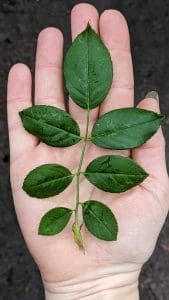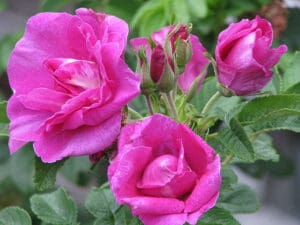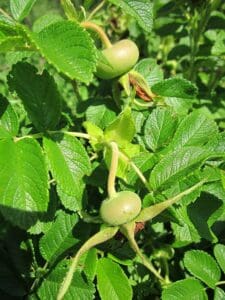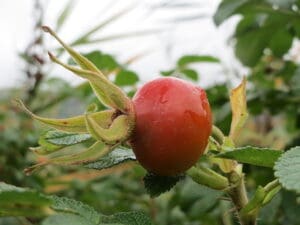Japanese Rose / Spring / Summer / Autumn / Edible
The Japanese Rose (Rosa rugosa) is a delight for me to collect, offering an abundance of edible flowers and vibrant rosehips. This hardy, fast-growing shrub is often found in coastal areas, parks, and gardens across the UK, recognised by its deeply veined, wrinkled leaves, fragrant pink or white blooms, and large, round hips.
The petals can be used fresh in salads or infused into syrups and desserts, while the rosehips, packed with vitamin C, are perfect for making jams, jellies, and herbal teas. Easy to identify and harvest, Rosa rugosa is a fantastic introduction to wild edible plants.
In this post, we’ll share how to identify, forage, and use the flowers and hips of the Japanese Rose to create delicious, nature-inspired treats.
Common Name
Japanese rose
Botanical Name
Rosa rugosa
Scientific Classification
Kingdom – Plantae
Order –Rosales
Family – Rosaeae
Physical Characteristics
A small to med shrub, covered in spines and thorns. Has a more dense and compact appearance compared to other roses like dog rose which looks more scrambling. Very beautiful, in fact it is a cultivation escapee, so originally used as decorative hedgerow.
Leaves
Pinnate with 5-7 leaflets (4-6 pairs and one on the end) growing on alternative sides of the stem.
Each leaflet is oval shaped with a serrated leaf margin. The leaflets are shiny especially when young and look slightly folded in the centre and lightly curved down, they also have lots of veins making them very textured.
The foliage is fairly dense, becoming a dark green with age.
Stem
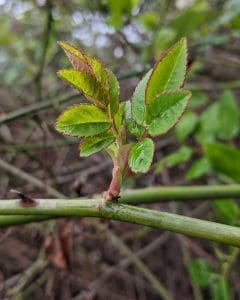
Green at first turning more brown and woody with age, rounded, covered in spines and thorns with a curve.
Flowers
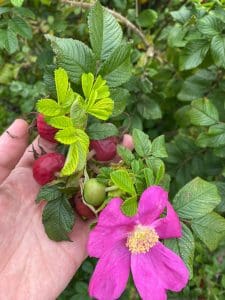
Bright, deep pink/purple flowers with many stamens. Usually with 5 petals but can have double layers of petals.
Each flower has 5 pointed sepals at the back, these are like little green leaves looking like a star behind the flower, they would have formed the bud before the flower opened. They have a faint sweet smell.
Fruit
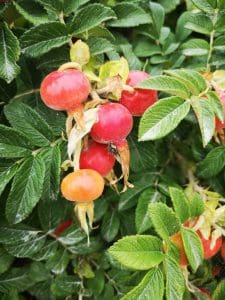
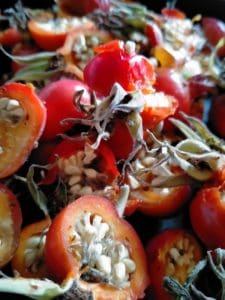
Bright orange/red rounded fruits called hips. These are shiny and have the remains of the sepals ( also referred to as the calyx) on the end of the fruit (these are 5 pointed green/ brown leaf like attachments) looking a lot like a cherry tomatoes.
The hips can have little spines so be careful when collecting and processing.
The outer flesh is fairly thin and tough, the centre is full of cream coloured seeds covered in irritating little hairs.
The rose hips are hard at first, only when the frost freezes them do them become soft
Habitat
Very common over England, can be seen mostly on coastal regions, sand dunes, hedgerow, scrub land, country lanes, road verges.
Non native, originating from eastern Asia, northeastern China, Japan, Korea and southeastern Siberia Brought where it likes to grow on the coast and sand dunes.
Bought over in the 19th century as a garden plant but escaped to the wild. Japanese rose has invasive tendencies and is on schedule 9 of the wildlife and countryside act, is some areas there are efforts to remove it and it is an offence to plant or allow this to spread in the wild. Valued by breeders for its considerable resistance to disease.
Known Hazards
Be careful of thorns and spines while picking.
The hairs around the seeds, not just of Japanese rose hips but all rose hips are like itching powder, so best not to get them on your skin. But become highly irritant if they get onto eyes or if eaten. Picture below is of Dog rose hip but the hairs look the same in all.
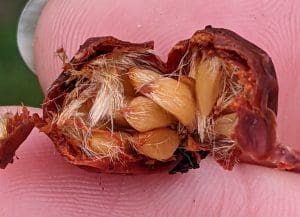
Safety during pregnancy is not yet established so best avoided
Could Be Confused With
Easily confused with other wild roses for example Dog Rose (Rosa canina) which is absolutely no problem as not one is poisonous! (Rose hip seed hairs should not be consumed across the board). The petals and hips of different species offered slightly different flavours and are to have an experiment with.
Look for deep pink flowers, rounded hips, a very spiny and thorny stem, and dense leaves that have a slight fold and curve to help differentiate it from the other wild roses.
Make sure you check the botanical name which will be in two parts- the genus then the species. To be certain you have the roses we are talking about here the first part should be ‘Rosa’, this is the genus for wild roses. The name rose with an E on the end is the common name and used across many species and families for both roses and other.
Edible uses
Japanese rose along with Rose petals and hips in general have been used for food, flavours and medicinal properties for centuries and warrant a guide of their own.
Flowers- from late spring to early summer so about May- June. The petals are the only part needed so if you carefully pull just the petals the rest of the flower will remain to go on to produce a rose hip. They will keep well for a few days in a cool place for long term storage they also dry well.
Rose hips- Autumn, the season is quite long for rose hips, they can be seen even in late summer and last on the shrubs well into January, but simply once the hips turn red they are ripe and ready to use. The traditional time to collect rose hips is just after the first frost as the freezing breaks the cells within making them softer and sweeter. This is called bletting, but we now have the modern technology of freezers so can start earlier if we wish.
When collecting your rose hips it will be useful to take a pair of gloves to protect from the thorns also some secateurs as it’s only when they are really soft do they come away from the stem easily.
Click here for our favourite Rose recipes.
Notes on Herbal uses
The rose hips have been one of the most used wild foods, they have been consumed for centuries especially during WW2 when imports of fresh fruit like lemons and oranges stopped people were paid to collect rose hip which were made into syrup , this was given to children in schools and people in hospitals because of its high vitamin C content. By 1943 500 tonnes were collected annually- enough to create 2.5 million bottles of syrup.
The Rose hips were where vitamin C was first discovered! according to Thomas Bartram in Bartram’s Encyclopaedia of Herbal Medicine.
Extra notes from the Foragers
Many will remember at school using Rose hips as a prank called ‘itchy back’ by opening a rose hip exposing all the itchy hairs and putting it down their victim’s shirt.
Rose flowers are a symbol of love and romance.
Resources



